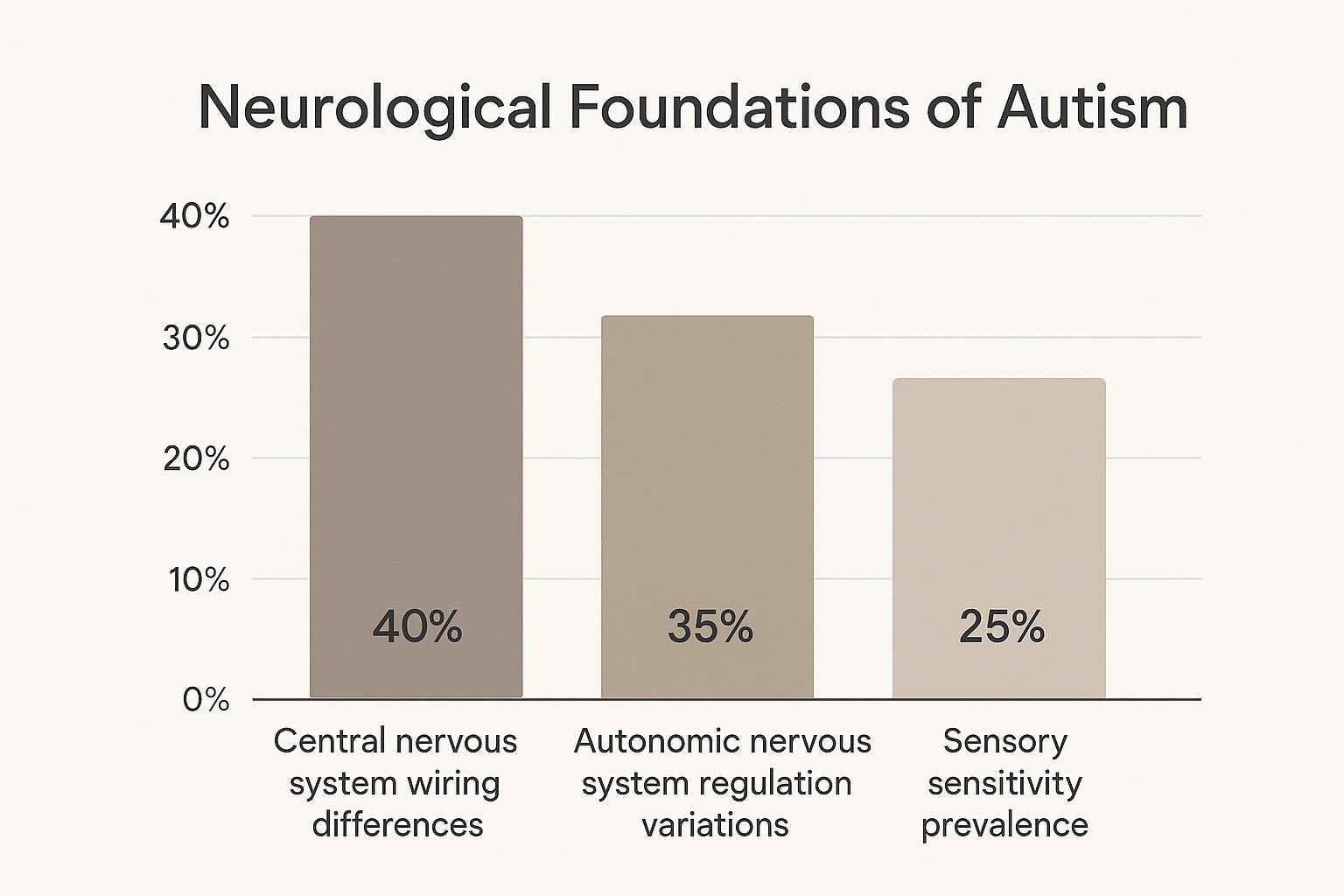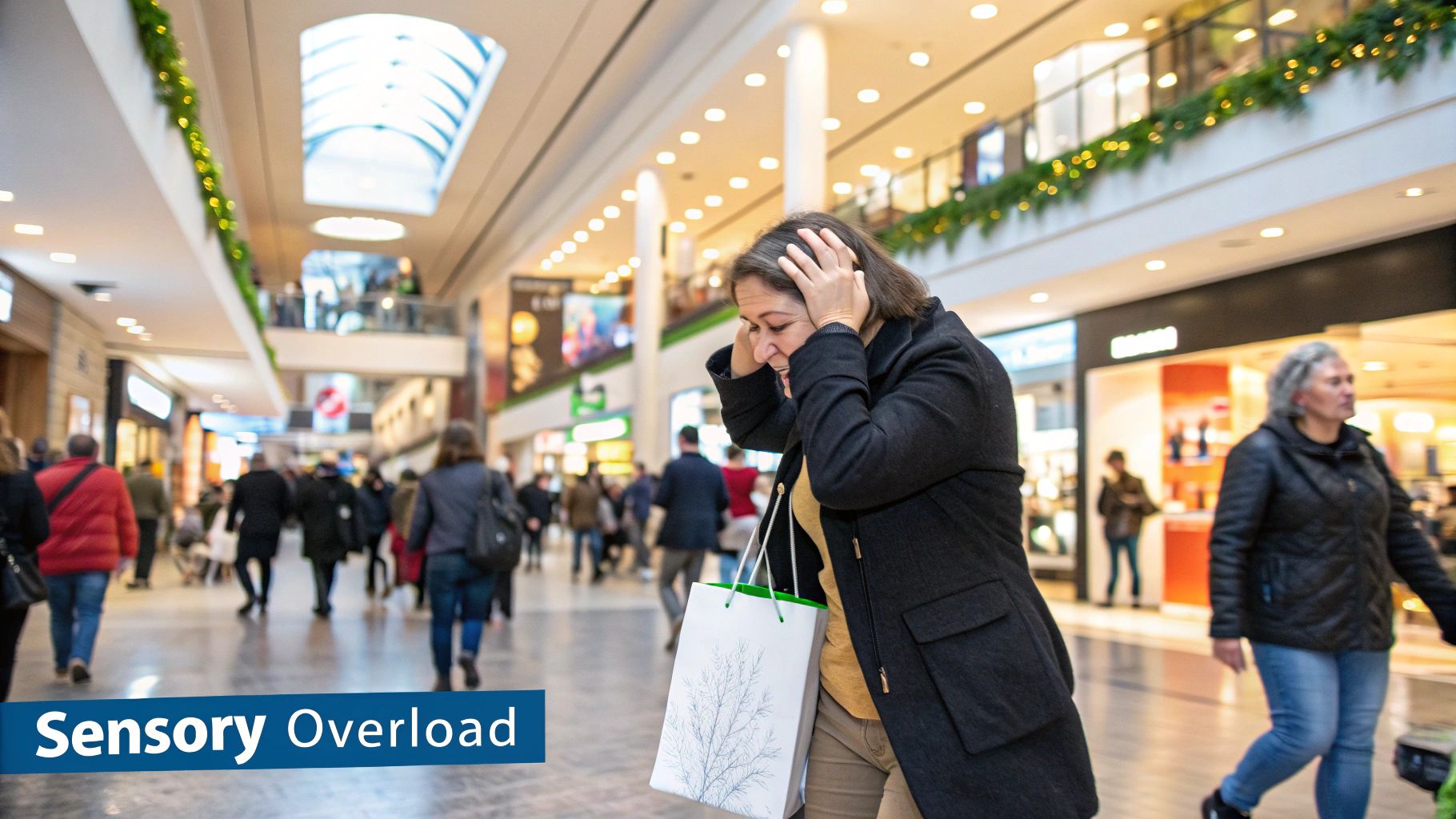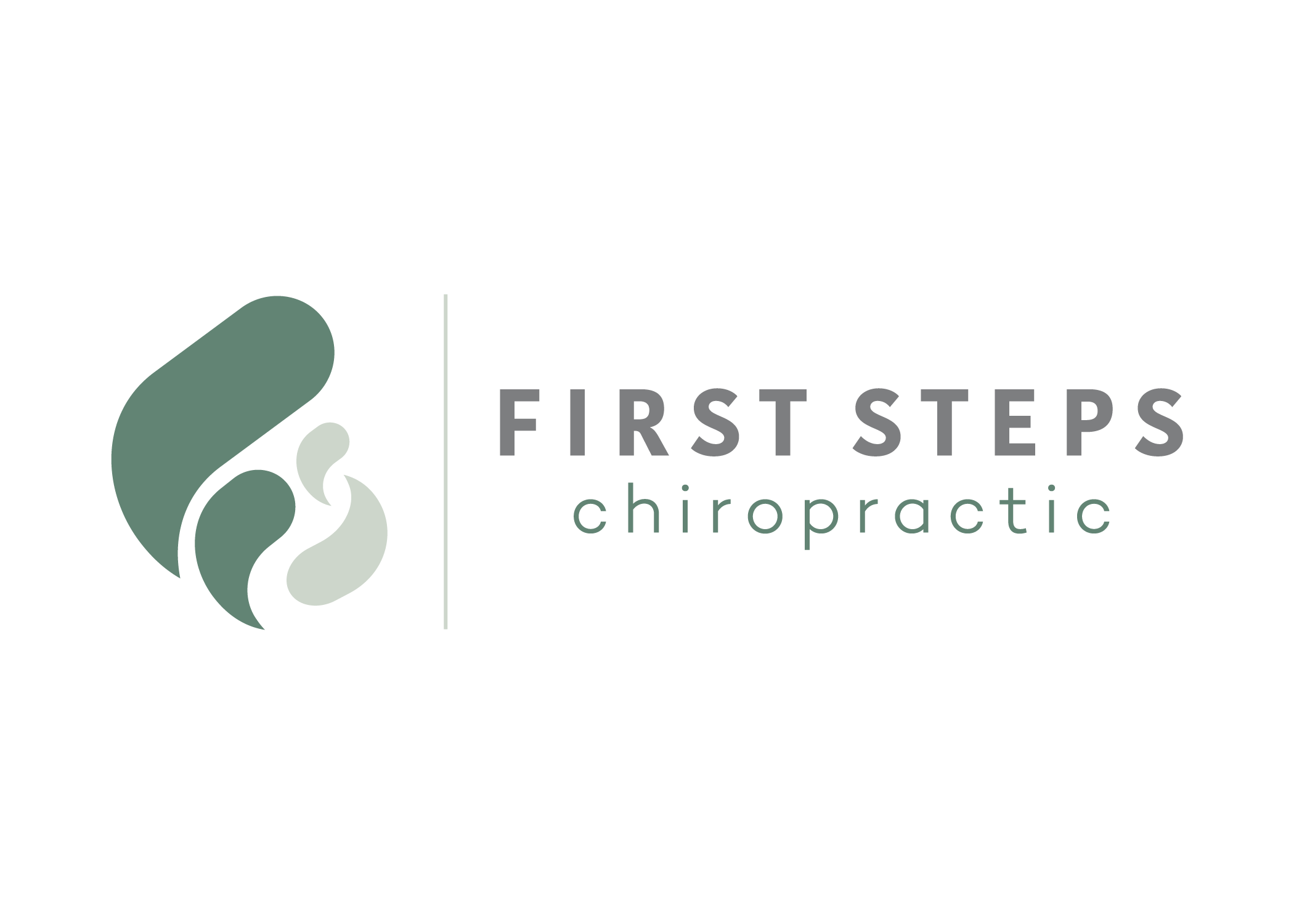At its core, autism is a neurological condition. This means it stems from foundational differences in how the brain and nervous system are structured and how they function. These neurological variations shape everything from sensory experiences and social communication to emotional regulation, drawing a straight line between autism and nervous system function.
The Neurological Roots of Autistic Experiences
To really get what's happening, we have to look past the behaviors we can see and dig into the neurobiology underneath. The autistic experience is fundamentally shaped by a nervous system that's just wired differently than the neurotypical standard. This isn’t a defect or a flaw; it’s simply a different way of experiencing and processing the world.
These differences show up most clearly in two major areas: the central nervous system (CNS) and the autonomic nervous system (ANS). The CNS, which is your brain and spinal cord, often shows unique patterns of connectivity in autistic individuals. This can lead to some incredible strengths, like an intense ability to focus and spot patterns, but it can also bring challenges, like difficulties with executive function or seeing the "big picture."
At the same time, the ANS—the part that controls all the automatic stuff like heart rate, breathing, and digestion—is often stuck in a state of high alert. This constant "fight-or-flight" mode is why an autistic person might be more prone to stress and anxiety, as their internal alarm system gets triggered much more easily.
This infographic gives a great visual of how these neurological differences contribute to the everyday autistic experience.

The data clearly shows that variations in brain wiring and autonomic regulation are huge factors, directly leading to the prevalence of sensory sensitivities. To go deeper on these topics, feel free to explore more about the neurological basis of autism in our other articles.
Core Neurological Components
Getting a handle on these systems provides some much-needed context for why certain autistic traits exist:
- Brain Connectivity: The brain's wiring can be atypical. Some regions might talk more within themselves (local over-connectivity) but less with regions that are farther away (long-range under-connectivity).
- Autonomic Regulation: A nervous system that defaults to a sympathetic ("fight-or-flight") state helps explain why a loud noise or an unexpected change in plans can feel completely overwhelming.
- Sensory Filtering: The brain can have a tough time filtering out sensory information that isn't important. This is what leads to sensory overload from lights, sounds, or textures that other people might not even register.
Seeing things from this neurological perspective changes everything. A meltdown isn't a "behavioral problem"; it's a genuine physiological response from a nervous system that has been pushed past its limits. Understanding this is the absolute first step toward providing support that is both effective and compassionate.
Decoding Sensory Processing in the Autistic Brain

Have you ever wondered why a bustling mall can feel like a physical assault for an autistic person, while a weighted blanket offers profound calm? These intense reactions are a direct result of how the autism and nervous system connection handles sensory information. It’s not about being "too sensitive"—it's about a brain that filters the world differently.
This experience is often categorized into two main types: hypersensitivity (over-responsiveness) and hyposensitivity (under-responsiveness). It's common for autistic individuals to experience a mix of both across different senses.
A key takeaway is that these sensory responses are not choices. They are genuine neurological reactions to an environment that the nervous system perceives as either dangerously overwhelming or insufficiently stimulating.
For instance, someone who is hypersensitive to sound might find the low hum of a refrigerator distracting or even painful. On the flip side, a person who is hyposensitive might actively seek out loud music or need to be called by name several times before they even register it.
Over-Responsive vs. Under-Responsive Systems
Understanding the difference between these two responses is the key to providing the right kind of support. A hypersensitive, or over-responsive, nervous system essentially turns the volume way up on sensory input. This amplification can make completely ordinary experiences feel unbearable.
In contrast, a hyposensitive, or under-responsive, system needs more input just to register that something is happening. This can look like a high tolerance for pain or a constant need for movement just to feel grounded in their own body.
Hypersensitivity vs Hyposensitivity A Daily Snapshot
To see how this plays out in real life, it helps to compare these responses side-by-side. The same sensory input can trigger wildly different reactions depending on how an individual's nervous system is wired.
| Sensory Input | Hypersensitive (Over-Responsive) Example | Hyposensitive (Under-Responsive) Example |
|---|---|---|
| Touch | Finds the seam in a sock or a tag on a shirt to be unbearably scratchy, causing significant distress. | Seeks out deep pressure, like tight hugs or piling on heavy blankets, to feel calm and regulated. |
| Sound | Hears the buzz of fluorescent lights as a loud, distracting noise that makes it impossible to focus. | May not notice their name being called in a quiet room or needs music turned up to a very high volume. |
| Sight | Becomes easily overwhelmed and nauseated by the bright, flickering lights of a grocery store. | Is drawn to flashing lights or spinning objects, finding them calming or fascinating. |
| Movement | Experiences motion sickness easily from car rides or swings, feeling dizzy and disoriented. | Needs to constantly rock, spin, or swing to feel their body's position in space (proprioception). |
| Taste | Is a "picky eater" because they are highly sensitive to specific textures or flavors, finding them foul. | Prefers very strong, spicy, or sour foods and may chew on non-food items like shirt collars or pencils. |
These examples show just how deeply sensory processing impacts daily functioning. What one person finds painful, another may not even notice.
Recognizing these variations is the first step toward creating environments that support regulation instead of triggering overwhelm. If you want to learn more about the specific signs, you can explore these common sensory processing disorder symptoms and see how they manifest day-to-day.
How Brain Connectivity Shapes Autistic Strengths

When we talk about the link between autism and the nervous system, you’ll often hear the phrase “atypical brain connectivity.” But what does that actually mean in the real world? It’s not about having a “better” or “worse” brain; it’s about having a differently organized one. This unique wiring is what gives rise to a remarkable set of cognitive strengths.
We can get a clearer picture by looking at two key ideas: local over-connectivity and long-range under-connectivity. A good way to visualize this is to think of it like a city's road system.
Hyper-Connected Neighborhoods
Local over-connectivity is like having a neighborhood with countless small, interconnected side streets. The neurons within specific, nearby regions of the brain have incredibly dense and efficient connections, creating an absolute powerhouse for processing things in fine detail.
This intense local wiring is often the neurological foundation for some incredible autistic strengths:
- Deep Focus: The ability to drop into a state of "hyperfocus," concentrating on a single topic or task for hours while filtering out nearly all distractions.
- Pattern Recognition: An exceptional talent for spotting patterns, anomalies, or tiny details in data, art, or complex systems that most people would miss.
- Systemizing: A natural drive to understand and build systems, whether that means memorizing train schedules, writing code, or organizing vast collections.
This isn't just about being good with details; it’s about having a nervous system that’s literally built for deep dives. The brain is optimized to process information intensely within these localized areas, which is a powerful cognitive asset.
This neural setup explains why an autistic person might excel at tasks that demand precision and specialized knowledge. A software developer might intuitively spot a single flawed line of code among thousands, or a musician might hear every distinct instrument in a complex orchestral piece. Their brain's wiring is perfectly suited for these detail-rich environments.
However, this same wiring can create challenges when information needs to travel across different brain regions. That’s where long-range under-connectivity comes into play.
The Autonomic Nervous System in a State of High Alert
Think of your body’s control center, the autonomic nervous system (ANS), as having two primary modes. There’s the sympathetic nervous system, our built-in “fight-or-flight” response that gears us up for stress and action. Then there’s the parasympathetic nervous system, the “rest-and-digest” mode that brings calm and promotes recovery.
For many autistic people, the nervous system gets stuck on high alert. The sympathetic side is chronically activated, keeping the body in a constant state of readiness for a threat that often isn't even there. This neurological reality is a huge piece of the puzzle when we talk about autism and nervous system regulation.
This persistent state of hyperarousal makes anxiety and stress feel like constant companions. It also completely reframes things like meltdowns and shutdowns. These aren't behavioral problems—they are physiological responses from a system that has been pushed past its breaking point.
Shifting from Behavior to Support
Grasping this neurological basis is a game-changer. It shifts the entire focus from trying to "manage" a behavior to providing compassionate support for an overloaded system. When someone is in a shutdown, for example, their body isn't being difficult; it's desperately trying to conserve energy after being flooded with sympathetic stress hormones.
This perspective is more important than ever. As awareness and diagnostic practices have improved, the prevalence of Autism Spectrum Disorder has seen a significant rise. U.S. data shows a jump from 1 in 150 children back in 2000 to 1 in 31 by 2022. This highlights a growing, urgent need for informed and compassionate approaches. You can dive deeper into these updated CDC findings on autism prevalence.
When we see a meltdown or shutdown as a physiological SOS signal rather than a deliberate act of defiance, our entire approach to support changes. We move from correction to connection, helping the person feel safe enough for their nervous system to downshift.
Ultimately, recognizing the ANS's role helps us understand why predictability, sensory-friendly environments, and co-regulation are so incredibly effective. These strategies don't just put a band-aid on symptoms; they directly address the underlying neurological state. They foster a sense of safety that finally gives the "rest-and-digest" system a chance to come online.
Actionable Strategies for Nervous System Regulation

It’s one thing to understand why an autistic nervous system gets overwhelmed, but it’s another to know what to do in the heat of the moment. Having practical, hands-on tools can shift the dynamic from constantly putting out fires to proactively creating a sense of safety and calm. The right strategies directly address the neurological needs of the person you’re supporting.
One of the most powerful tools in our toolbox is proprioceptive input, which is the body's sense of its own position and movement. For a nervous system that's spinning out, this kind of input is incredibly grounding.
You can provide this calming deep pressure through simple, everyday activities:
- Heavy Work: Think about tasks that involve pushing or pulling. Carrying groceries, pushing a vacuum cleaner, or even stacking heavy books provides resistance that helps the nervous system organize itself.
- Deep Pressure: A weighted blanket or lap pad can work wonders. Even a firm, steady hug offers containing pressure that signals safety to the brain.
- Chewing: Offering crunchy snacks like carrots or pretzels, or providing safe chewable jewelry, gives regulating input through the jaw.
Creating Predictable and Safe Environments
A chaotic environment will always drain a person’s ability to stay regulated. Creating spaces that are predictable and sensory-friendly isn’t an indulgence—it’s a fundamental need.
This often means reducing clutter, swapping harsh fluorescent lights for softer lamps, and sticking to clear, consistent routines. When life is predictable, it lessens the mental energy needed just to get through the day, which helps lower that constant state of high alert. Something as simple as a visual schedule can remove the anxiety of not knowing what’s coming next.
A core principle of this support is co-regulation. This happens when a calm, regulated adult essentially lends their stable nervous system to someone who is distressed. It’s about being a calm anchor in their storm, not just telling them to "calm down."
This kind of proactive support is so important, especially when you look at the bigger picture. With ASD prevalence increasing nearly five times since 2000, there are still major gaps in care. In fact, research shows that 1 in 9 children with autism doesn't receive the healthcare they need. You can read more about these trends and the societal impact of autism on AutismSpeaks.org.
Ultimately, these strategies empower everyone involved. By focusing on practical tools and simple environmental tweaks, we can build a strong foundation for well-being, connection, and effective nervous system regulation.
Common Questions About Autism and the Nervous System
As we dig deeper into the connection between autism and the nervous system, it's natural for a few key questions to pop up. Let's tackle some of the most common ones to give you a clearer, more confident understanding.
Is Autism Just a Brain Condition?
This is a big one. While the brain is obviously a major player, it's far more accurate to view autism as a whole-body neurological difference. It’s not just about what's happening "upstairs."
The autonomic nervous system—the part that runs on autopilot managing things like heart rate, breathing, and digestion—is often stuck in a high-alert, "fight or flight" mode. This directly shapes emotional regulation and sensory responses throughout the entire body, not just in the brain.
Can You "Grow Out of" Autism?
Because autism is a neurodevelopmental difference, it means the nervous system is wired in its own unique way from the very beginning. So, no, you can't simply "grow out of" it.
What can happen, though, is that autistic individuals learn incredible strategies to regulate their nervous systems. With the right support, they absolutely can, and do, thrive.
Is Autism Hereditary?
Many families wonder if there’s a genetic link, and the research points to a strong "yes." Genetics definitely play a significant role. If you have one autistic family member, the odds are higher that others in the family may be autistic as well.
But it isn't as simple as a single "autism gene." It's more of a complex mix of many different genes, likely combined with environmental factors that influence how a baby’s brain and nervous system develop early on.
How Does Prevalence Vary?
It's a common misconception that autism rates are the same everywhere. The numbers actually tell a different story.
Globally, about 0.77% of children have an ASD diagnosis, with boys still being diagnosed more often than girls. In the U.S., you'll even see different rates among various ethnic groups. This really underscores how important it is to have culturally aware diagnostic practices and support systems. You can dive into the data on global autism prevalence at pubmed.ncbi.nlm.nih.gov.
The biggest takeaway here is that to truly understand autism, we have to look past behaviors and see the neurological roots. When we see it as a nervous system difference, we can offer more compassionate, effective support that honors each person’s unique experience.
By tackling these common questions head-on, we can help build a more informed community—one that’s better prepared to support the real neurological needs of autistic individuals.
At First Steps Chiropractic, we're passionate about helping families understand and support their nervous systems. Our neurologically-focused approach is designed to help your child find balance and build resilience. To see how we can support your family's journey, schedule a complimentary consultation with us today.

